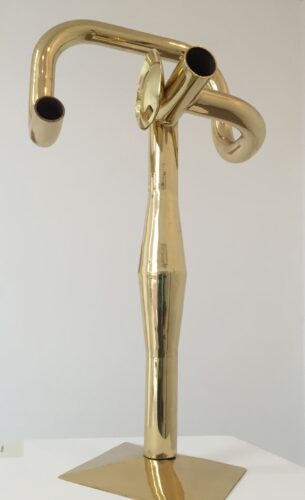Itzhak Danziger
Sacred Place
Curator: Dvora Liss
February-November 2016

Yitzhak Danziger’s (1916–1977) drawings are featured as a self-contained exhibition within the larger show entitled “A New Horizon for New Horizons.” Born in Germany, Danziger immigrated to Palestine with his family as a boy. He left for art studies at the Slade School of Fine Art in London in 1934, where he was first exposed to Assyrian and Egyptian sculpture, and subsequently developed a topical artistic approach which assimilated primitive gestures and materiality. Upon his return to Palestine in 1938, he became the life and soul of a group of artists from various fields who fostered Canaanite inclinations. In 1956 Danziger joined New Horizons, introducing works which were current and local at the same time, adopting the myth of the indigenous native man which was intertwined with contemporaneous forms and materiality.
The exhibition presents Danziger’s drawings from the early 1940s on: works perpetuating his impressions of the country’s vistas, inspired by such events as the sheep-shearing festival, variations on altars and sacrificial offerings, local rituals and folklore. These are joined by numerous drawings depicting bound sheep and rams, as well as men and women, likewise sprawled on altar-like structures. Some of the drawings contain quotes from the bible serving as references to the time and place of occurrence: “Beit El,” “Mt. Zion,” “Priests,” “Sacrifice,” “The Binding of Isaac.” These drawings consist of a generalized depiction of an altar-like stage whose corners are sometimes adorned with rams’ heads, and the sacrificer—whether man or animal—takes his place by its side. At times, the human being is the sacrifice, and the sheep is the altar, as a reversal of the Binding story. Danziger presents the terrible existential alternative whereby, in the absence of divine intervention, society is doomed to sacrifice its sons: possibly an allusion to fallen warriors, perhaps the artist’s reference to the need for a sacrifice to reduce the gap between man and nature.
Danziger believed that the artist must adhere to the natural world. He focused on the local terrain and the rituals typical of the place, which he explored tirelessly, and was particularly interested in the link between natural landscapes and the sites or places marked by tombs or monuments, erected as “memorials.” Danziger drew on the land’s ancient heritage, and was profoundly attuned to the structures, trees, and ritual objects of its local landscape. He was enchanted by the idea of the mukam (makom in Hebrew), a structure in the form of a sheikh’s tomb used as a sanctuary for seclusion in nature, a cell for introspection, or simply a place in which to tarry. Originating in religious ritual, the mukam symbolizes the most intimate and exalted bond between man and his natural habitat. In Hebrew, the word makom, place, is also one of God’s names. Rather than a chance homonymy, it attests to the profound interrelations between God and the place.
We have intentionally situated Danzinger’s work in the Judaica wing, the Museum’s only permanent exhibition space. The Museum’s founders regarded Jewish ceremonial appurtenances as integral to its larger collection, and looked to Jewish tradition as the foundation for the new Israeli culture, in whose constitution they wished to partake. At the same time, the Judaica wing presents quite a challenge: to make those seemingly antiquated ritual objects and the practices associated with them relevant to contemporary life. Exhibiting Danziger’s drawings in the Judaica wing enables us to appreciate the significance of the place (makom), the site of meditation and introspection which triggers memories important to both Danziger and the Museum’s founders.

